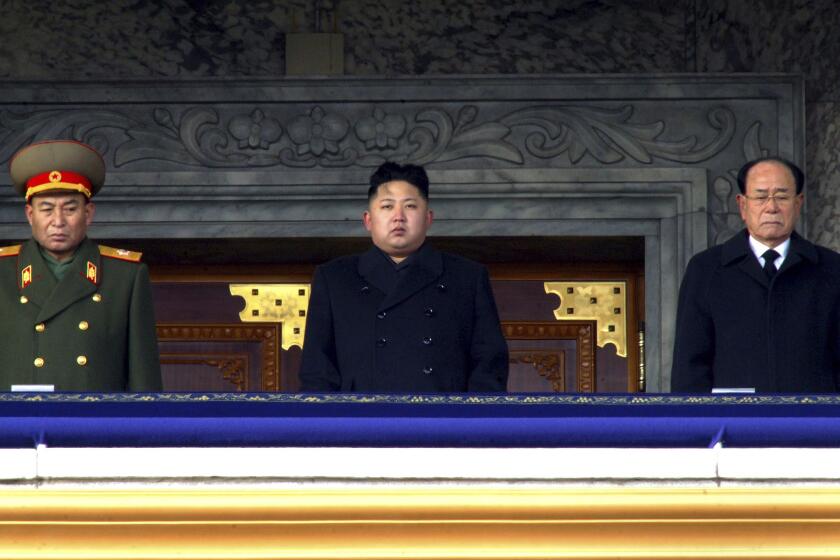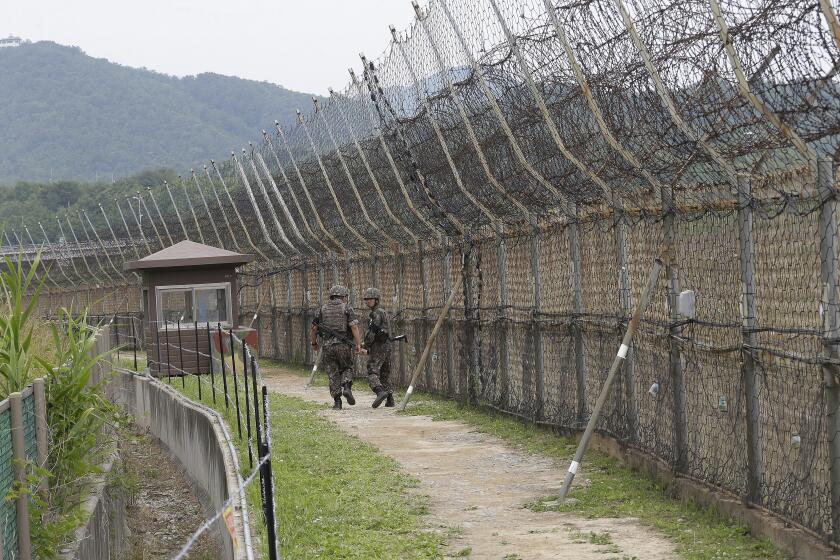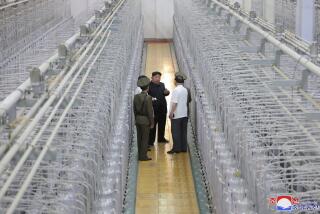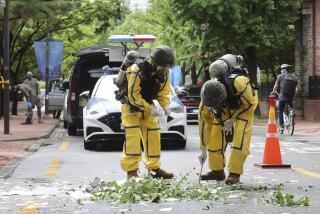North Korea confirms test of a missile capable of striking Guam
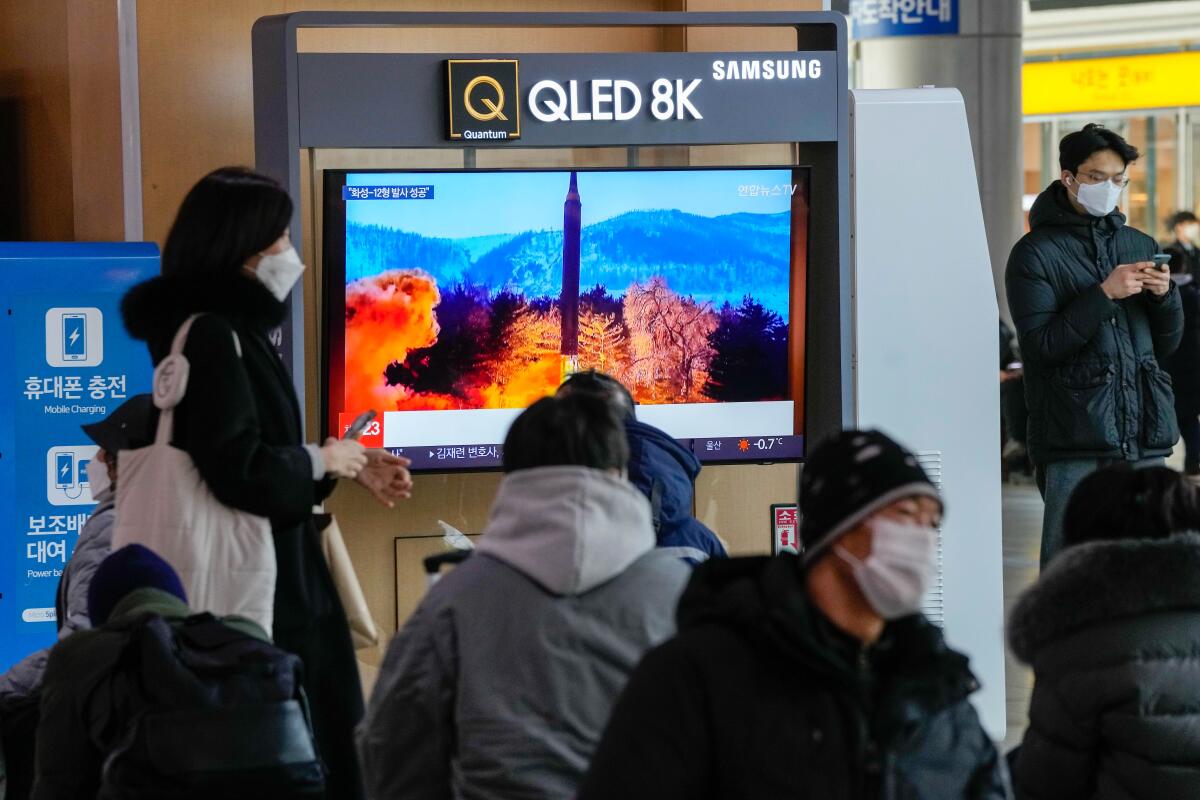
- Share via
SEOUL — North Korea confirmed Monday that it test-launched an intermediate-range ballistic missile capable of reaching the U.S. territory of Guam — Pyongyang’s most significant weapons launch in years — as Washington plans steps to show its commitment to its Asian allies.
Sunday’s launch could be a prelude to bigger provocations, such as tests of nuclear and long-range missiles that pose a direct threat to the U.S. mainland, as Pyongyang tries to pile more pressure on the Biden administration for sanctions relief or international recognition as a legitimate nuclear state.
North Korea’s official Korean Central News Agency said the purpose of the test was to verify the overall accuracy of the Hwasong-12 missile being deployed by the North Korean military.
Pyongyang said the missile was launched toward waters off its east coast on a high angle to prevent flying over other countries. It gave no further details.
According to South Korean and Japanese assessments, the missile flew about 500 miles and reached a maximum altitude of 1,242 miles before landing in waters between the Korean Peninsula and Japan.
The reported flight details make it the most powerful missile North Korea has tested since 2017, when the country launched Hwasong-12 and longer-range missiles in a torrid run of weapons firings to acquire an ability to launch nuclear strikes on U.S. military bases in Northeast Asia, the Pacific and even the American homeland.
North Korean leader Kim Jong Un reaches 10 years in power
KCNA published two sets of combination photos, one purporting to show the missile rising from a launcher and soaring into space and the other showing North Korea and nearby areas that it said were photographed from space by a camera installed at the missile’s warhead. The authenticity of the photos could not be independently verified.
Lee Choon Geun, a missile expert and honorary research fellow at South Korea’s Science and Technology Policy Institute, said he thought the photos were indeed taken from space, especially when the missile was soaring to its apogee, but he could not independently prove that the images had not been modified. While it’s rare to place a camera on a weapon, Lee said North Korea likely wanted to demonstrate its technological advancement to both foreign and domestic audiences.
The Hwasong-12 missile is a nuclear-capable ground-to-ground weapon with a maximum range of 2,800 miles when fired on a standard trajectory. It’s a distance sufficient to reach Guam, home to U.S. military bases that in previous times of tensions sent advanced warplanes to the Korean Peninsula in shows of force. In August 2017, at the height of animosities with the Trump administration, North Korea threatened to make “an enveloping fire” near Guam with Hwasong-12 missiles.
In 2017, North Korea also test-fired intercontinental ballistic missiles, called Hwasong-14 and Hwasong-15, that experts say demonstrated their potential ability to reach the mainland U.S. Some analysts say North Korea still needs to conduct additional ICBM test-flights to prove that it has overcome the last remaining technological hurdles, such as protecting a warhead from the extreme heat and pressure of reentering the Earth’s atmosphere.
While tens of thousands risk everything to flee North Korea, a few, having failed to adjust to the capitalist South, make a desperate journey back.
In recent months, North Korea has launched a variety of weapons systems and threatened to lift a four-year moratorium on more serious weapons tests such as nuclear explosions and ICBM launches. Sunday’s launch was the North’s seventh round of missile launches in January alone, and other weapons tested recently include a developmental hypersonic missile and a submarine-launched missile.
Analyst Cheong Seong-Chang at the private Sejong Institute in South Korea said the Hwasong-12 launch was seen as partially breaking North Korea’s weapons test moratorium. In April 2018, when North Korea suspended nuclear and ICBM tests ahead of its diplomacy with the Trump administration, Kim said North Korea also no longer needed to test intermediate-range missiles.
Cheong said North Korea would likely test-launch its existing long-range missile if the U.S. helps bring about fresh international sanctions. Other experts said North Korea could also conduct a nuclear test.
North Korea has publicly vowed to add more powerful ICBMs and nuclear warheads in its arsenal. They include a longer-range ICBM with precision-strike capability, a solid-fuel ICBM that improves a weapon’s mobility, a multi-warhead missile, a spy satellite and a super-sized warhead.
North Korea’s new missiles tests renew concerns that the country is building its capacity to deliver strikes on U.S. allies South Korea and Japan.
After Sunday’s launch, White House officials said they saw the latest missile test as part of an escalating and increasingly concerning series of provocations over the last several months.
The Biden administration plans to respond to the latest missile test in the coming days with an unspecified move meant to demonstrate to Pyongyang that the U.S. is committed to the security of its allies in the region, according to a senior administration official who briefed reporters on the condition of anonymity.
The official said the administration viewed Sunday’s missile test as the latest in a series of provocations to try to win sanctions relief from the U.S. The Biden administration again called on North Korea to return to talks but made clear that, at this point, Biden doesn’t see as constructive the sort of leader-to-leader summits former President Trump held with Kim.
South Korean and Japanese officials also condemned Sunday’s launch, which violated United Nations Security Council resolutions that ban North Korea from testing ballistic missiles and nuclear weapons.
Breaking News
Get breaking news, investigations, analysis and more signature journalism from the Los Angeles Times in your inbox.
You may occasionally receive promotional content from the Los Angeles Times.
U.S.-led diplomacy aimed at convincing the North to abandon its nuclear program largely remains stalled.
“Even if Washington had the bandwidth to pay more attention to the North Korean nuclear issue, Pyongyang would likely continue to refuse direct talks because of the pandemic, keep perfecting its weapons technology and maintain its high price tag for talks,” said Duyeon Kim, an analyst at Washington’s Center for a New American Security.
Observers say North Korea could suspend weapons tests during the Beijing Winter Olympics because China is its most important ally. But they say North Korea could test bigger weapons when the Olympics end and the U.S. and South Korean militaries begin their springtime military exercises.
More to Read
Sign up for Essential California
The most important California stories and recommendations in your inbox every morning.
You may occasionally receive promotional content from the Los Angeles Times.
